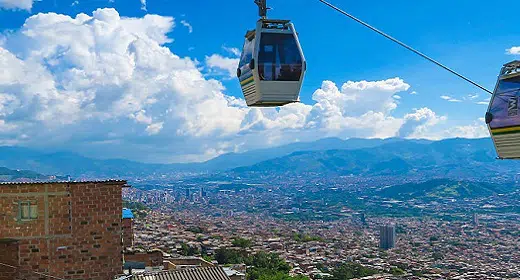by Linnea Harris: In cities across the globe, urbanites rely on public transportation to get around…
More than 55% of the global population lives in urban areas, a number that is expected to increase to nearly 70% by 2050, according to the UN. As our cities grow, so must public transportation capacity, while also addressing the mounting impacts of climate change and the role of our fossil fuel powered transportation system.
A few cities and countries are already accommodating the needs of their occupants and our climate by building innovative systems of transport.
Luxembourg
If you’re planning a journey to Luxembourg, scratch “book rental car” off of your to-do list. In March 2020, this small European country became the first to offer free public transportation to its citizens and visitors.
The free access to buses, trains, and trams for all 630,000 Luxembourgers makes it possible to explore the entire Rhode-Island-sized country without a car. Bike paths and hiking trails stretch between the stations, and riders can travel to neighboring countries at a reduced price.
Luxembourg – a country with many job opportunities and a high GDP – is infamous for congestion issues, with 681 cars per 1,000 people. Dany Frank of the Ministry of Mobility and Public Works cites environmental benefits and reduced traffic as major motivations for the change, reports CNN.
Switzerland
Home to the Alps and the Jura Mountains, Switzerland boasts stunning alpine views and picture-perfect destinations – if you can get to them. Its windy mountain passes are often difficult to traverse by car, especially in adverse weather conditions.
For decades, the Swiss have avoided this conundrum with their iconic car trains. Personal vehicles and buses alike can drive right onto one of six trains (two of which travel to Italy) and enjoy the ride from the comfort of their car or a passenger sitting area as they travel through tunnels and mountain passes. During busy hours, some trains run as often as every 15 minutes, making this form of transport a viable option for travel while cutting down on emissions and overall transportation time.
Shanghai, China
While standing on the train platform in Shanghai, you won’t hear the deafening racket expected of most trains; the levitating Maglev train arrives quickly and quietly.
Maglev trains – whose name is an abbreviation of “magnetic levitation” – employ magnetic technology to levitate the frictionless, wheel-less trains over the tracks. The trains utilize the concept of electromagnetic propulsion, by which superconducting magnets repel one another and suspend the train over the guideway.
Powered entirely with electricity, these trains are both environmentally friendly and extremely fast. In 2015, one Maglev train broke the all-time speed record for trail vehicles, hitting 603 kph (375 mph). The Shanghai line running between the Longyang Road Station and Pudong International Airport stretches 19 miles (30 km), and the trip takes only seven and a half minutes from end to end. If Maglev technology were used to build high-speed trains in the U.S., travelers leaving New York City could expect to reach Los Angeles in seven hours.
The network of Maglev lines in China is still small, but spreading. A line connecting Shanghai and Hangzhou is under construction, reports CNN, with another between Chengdu and Chongqing. Maglev trains also run in Japan and South Korea, and a new line is expected to link Tokyo and Nagoya by the year 2027 with a total travel time of only forty minutes.
Hamburg, Germany
Hochban – the transit authority that runs much of the public transportation in Hamburg – is replacing its entire fleet of 1,100 diesel buses with zero-emission vehicles by 2030. The e-buses create 75% fewer emissions than their diesel counterparts, and a total fleet-wide conversion would reduce CO2 emissions by 65,000 tonnes every year (the equivalent of 32500 gasoline-powered cars driving for one year).
The transition to carbon-neutral transportation is made possible in part by the recharging stations for buses located in the city. The interoperability of the system is the real innovation, and allows buses – regardless of their manufacturer – to pull into a charging station and refuel in only six minutes: enough for an entire day on their route. This means the city can source buses from different suppliers moving forward and still function with their existing charging technology.
Trondheim, Norway
While not exactly a large-scale public transportation system, this Norwegian city is transforming bicycle commutes for its citizens.
Trondheim is famous for the Trampe Bicycle Lift, invented and installed by Jarle Wanwik in 1993, who was tired of biking up a huge hill every morning on his way to work. The lift is, basically, an escalator for all self-propelled vehicles, like scooters, strollers, skateboards, and, of course, bikes. Rides place one foot on a small, moving platform that travels up the track, pulling the cyclist up with it.
Since its original installation, the Trampe has been upgraded by the French company SKIRAIL, and can carry five people up the hill at once.
Adelaide, Australia
Adelaide – the capital city of South Australia – is the fifth most populous in the country at 1.3 million inhabitants, and home to the brilliant green, solar-powered Tindo buses.
Tindo – the Aboriginal word for “sun” – doesn’t have a combustion engine, and is the first 100% solar-powered electric bus in the world. Unlike other solar-fueled vehicles that sport solar panels on their bodies, these buses are charged with solar power at bus stations and can travel up to 200 kilometers between charges. These buses were commissioned from New Zealand’s Designline International, and are run by the city council as a part of the Adelaide Connector Bus service.
They produce no emissions, can transport up to 40 people, and cost nothing for the traveler. The buses are also cheaper for the city, and cost 50% less per kilometer to operate than diesel vehicles. They also employ a regenerative braking system, which reduces energy consumption by 30%.
Amsterdam, Netherlands
You’ve seen self-driving cars, but what about a self-driving boat?
The Roboat (pun intended) was designed by scientists at the Massachusetts Institute of Technology and the Amsterdam Institute for Advanced Metropolitan Solutions. Two full-scale Roboats were launched in 2021 to traverse the 100 kilometers of waterways in Amsterdam, capable of transporting up to five people, carrying goods, and collecting waste. These totally autonomous, wirelessly-charged boats are powered by propellers and thrusters, and are monitored on shore from a central location that can oversee dozens of boats at once.
The self-driving technology uses a GPS and sensors referred to as “perception kits,” which can detect unknown objects and categorize them for future encounters. While not yet used for transporting the public, these innovative boats are making cleaner, water-based urban travel a greater possibility for Netherlanders and the world.
Medellín, Colombia
This city of two and a half million stretches up the slopes of the Andes, along which floating gondolas travel up and down.
Instead of bringing people up and down ski slopes, the Metrocable connects isolated areas of the city, allowing people who live in the informal dwellings on the hillsides to reach the city center. Buses were once the only way to reach the city below, requiring multiple fees and nearly two hours, while the cable cars take as little as 30 minutes on one of four lines.
Medellín was once the world’s most dangerous city, but these gondolas are credited with the massive transformation of the area, giving its citizens greater access to work, education, and health care. City tour guide Pablo Alvarez Correa calls the cable cars “an innovative solution to the problems of geographic and economic exclusion,” reports Business Insider.
















































